Well i put a new coil on it, new points, and checked some of the wiring, found a couple of wires that had melted together, fixed them, started it and measured the volts on one side of coil, almost fifteen, measured the other side, goes from 7 to 11 volts, dose'nt have a resistor wire, it has a one of them ceramic resistors on the firewall, pulled it off and looked at it, dosent look bad, the fuse spring deal is still in one piece. How do you know if it is bad, and what is the correct way to check the volts going to the points, just check the side of the coil that goes to the distributor? Thanks for any and all advice. Bob
You are using an out of date browser. It may not display this or other websites correctly.
You should upgrade or use an alternative browser.
You should upgrade or use an alternative browser.
- Thread starter molinebob
- Start date
Anonymous-0
Well-known Member
I'd be looking to see if someone bypassed the resistor.
elmersooner
Member
resistors work like lightbulbs either they carry current or they don't...numbers don't sound right to me---as rusted said trace those wires down.
I just dont know if that 12 volt truck (like many old farm tractors) uses a series voltage dropping (12 to 6) ballast resistor and a 6 volt coil or not?????????
If so?????? With the ignition on truck not running and ignition points closed, Id expect 12 volts to the ballast input but only 6 to 7 on the ballast output which wires to the coils input (NOT to distributor) terminal. With the points closed, theres of course zero volts on the coils to distributor terminal.
With the truck running if the charging system works the input voltage would rise to over 13.
A typical tractor ballast resistor is in the range of 1.5 to 2 ohms but Im unsure on that truck.
If the ballast is by passed or shorted out that would put like 12 volts on a 6 volt coil and it will overheast plus the poinst burn up quickly
Take a look at my Ignition Troubleshooting provedure for coil ignition on old tractors as it may still help on that truck
John T
John Ts Ignition Troubleshooting
If so?????? With the ignition on truck not running and ignition points closed, Id expect 12 volts to the ballast input but only 6 to 7 on the ballast output which wires to the coils input (NOT to distributor) terminal. With the points closed, theres of course zero volts on the coils to distributor terminal.
With the truck running if the charging system works the input voltage would rise to over 13.
A typical tractor ballast resistor is in the range of 1.5 to 2 ohms but Im unsure on that truck.
If the ballast is by passed or shorted out that would put like 12 volts on a 6 volt coil and it will overheast plus the poinst burn up quickly
Take a look at my Ignition Troubleshooting provedure for coil ignition on old tractors as it may still help on that truck
John T
John Ts Ignition Troubleshooting
Lou from Wi.
Well-known Member
Molinebob,here's a few photos from our old chilton book on 71-78 Fords,The photos are for points type distributor and the wiring diagram is also.Hope it helps.
Victor
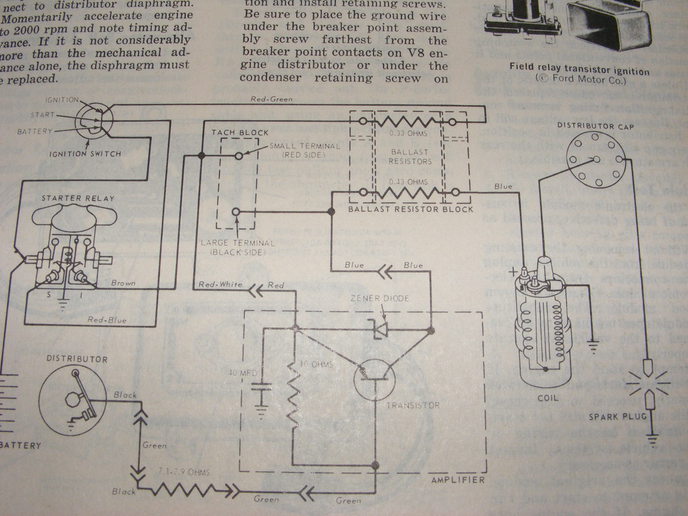
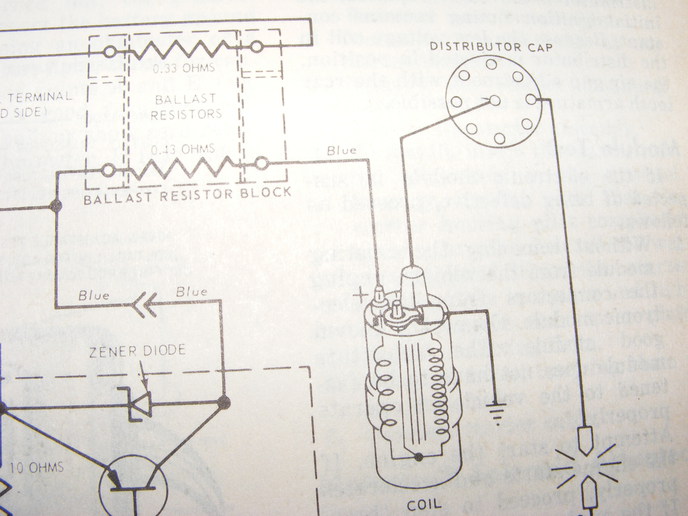
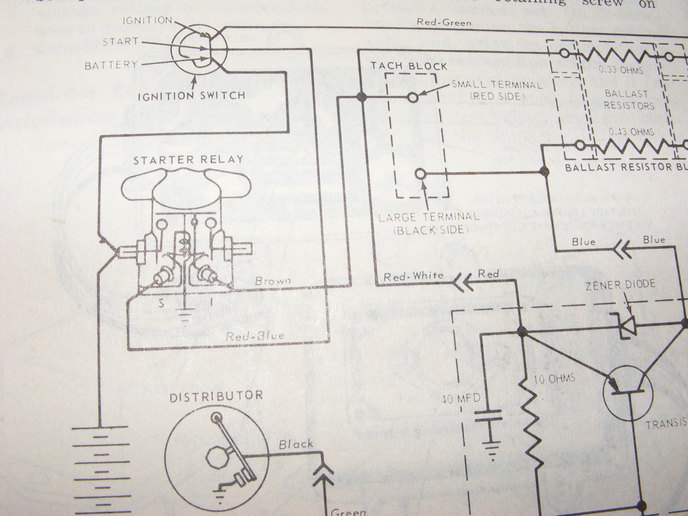

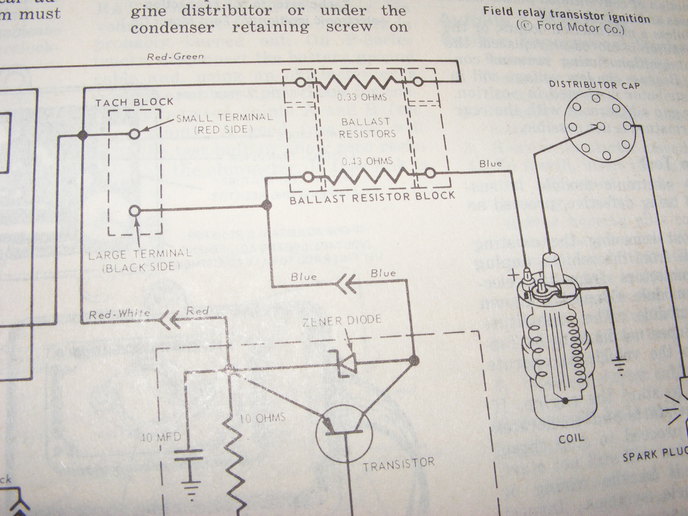
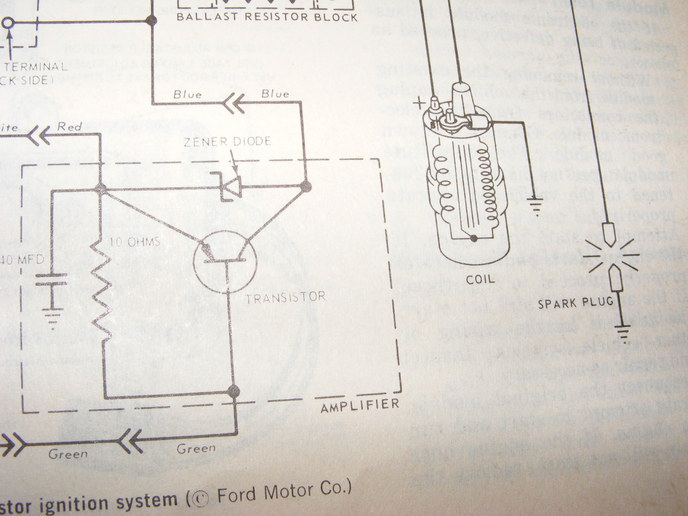
Victor






My 2 cents worth: I put a rebuilt motor in a Jeep J 20. For about $150 bought an HEI distributor. Instalation was as easy as droping it in, running 12 volts to it, and setting the timing. No points, no resistors, no condensor, and much better spark. I'll never mess with anything else again.
Brian Jasper co. Ia
Well-known Member
No, 74 was last year for points. 75 was SSI (solid state ignition) 76 was 1st year for Dura Spark.
With it running, the voltage you were getting on the neg side of the coil doesn't mean anything. What you are seeing is an averaged voltage due to the off and on switch of the points. You have to read the voltage on the negative side of the coil with the engine off and the points open.
Sounds to me like it needs a new, or bigger capacity condenser. Without a good condenser the point contacts will burn up causing bad running and with a shut down, it won't start again.
Sounds to me like it needs a new, or bigger capacity condenser. Without a good condenser the point contacts will burn up causing bad running and with a shut down, it won't start again.
TomA in CA
Member
I doubt if you can buy a decent set of points anymore. I know back when I was running "73"s and 4"s points were crap. No more tungsten, just some kind of plating. Part of "70"s smog control was frequent tune ups. Wires didn"t last, caps didn"t last, points didn"t last. I would keep an eye out for a HEI, should be a junkyard item nowadays.
Early Dodge transistor ignitions had the dual resistor in the ignition ignition.I found one with an open resistor.I was out of auto mechanics then but helped a friend who had a gargage test them.Dufus may have jumped the open section of the resistor or moved the wires around.
Voltage is too high to the points and needs to be stepped down. If I remember correctly the R terminal on the solenoid which is on the fenderwell goes to a resistor wire. I don't remember it being a ceramic resistor block. The resistor is bypassed during cranking to provide full battery voltage to the coil to aid in starting. If I remember correctly the running voltage should be around 10 Volts. Hope this helps. Gerard
if it's a straight mechanical / points ignition.. I tell you what I would do..
get a universal 12v coil like a napa IC14SB, and use that and do away with any resistor or resistor wire..
1v straight from start and run terminal on key to coil and go.
works fine in a tractor...
electrons don't care too much if it's in a truck.. etc..
soundguy
get a universal 12v coil like a napa IC14SB, and use that and do away with any resistor or resistor wire..
1v straight from start and run terminal on key to coil and go.
works fine in a tractor...
electrons don't care too much if it's in a truck.. etc..
soundguy
Kentb of SWMO
Well-known Member
Buy a internal resister coil and a Pertronix ignition system to replace the points and condenser.
Kent
Kent
I challange you to find a 'internal resistor coil' that is currently made.
coils are now made with the correct number of turns of the correct gauge wire for their intended primary resistance... they are usually oil potted too, instead of epoxy potted... at least the better ones are.
You don't pop them open and find a lil resistor hiding in the can..
soundguy
coils are now made with the correct number of turns of the correct gauge wire for their intended primary resistance... they are usually oil potted too, instead of epoxy potted... at least the better ones are.
You don't pop them open and find a lil resistor hiding in the can..
soundguy
don t-9n180179
Member
FWIW....I have a 70 GMC survivor that had bad dizzy bushings. Instead of fixing, I put in a HEI dizzy from Skip White. IIRC it was $50 plus shipping. I kept the original coil and the dizzy has a spot for the middle coil wire. If yoyu didn't know any better, you'd think it was original.
If you have 15 V on the coil (+) terminal and 7-11 V on the (-) you have several possible problems.
I"m presuming you took these readings with the engine not running. If you took them with the engine running with an digital meter they are probably not correct unless you have a well shield VOM.
If the points are closed when you get these readings, you should have near zero on the (-) coil terminal and battery voltage on the (+) terminal.
If the points are open when you get these readings, you have a short somewhere in the coil. The readings should both be battery voltage.
I"m presuming you took these readings with the engine not running. If you took them with the engine running with an digital meter they are probably not correct unless you have a well shield VOM.
If the points are closed when you get these readings, you should have near zero on the (-) coil terminal and battery voltage on the (+) terminal.
If the points are open when you get these readings, you have a short somewhere in the coil. The readings should both be battery voltage.
Kentb of SWMO
Well-known Member
I buy them all of the time at my local auto parts store. The are marked No external resister needed. You I know there is just more wire winding BUT electrically IT IS the same as a internal resister.
PICKEY,PICKEY,PICKEY
Kent
PICKEY,PICKEY,PICKEY
Kent
This system dosent use a condensor on the points.The transistor reduces the current handled by the points.I used a system like this in a 38 Dodge.I worried that the transistor handling the inductive voltage would fail but it worked. This was in the mid 50s.One expert said the transistor I used didnt exist then,I do have trouble remembering things from almost 60 years ago.I do remember the 57 Ford radios used a 2n301 in the audio output.Delco used the DS501 I may have used that one.In any case look at the schematics posted.
It took me a while to figure out why Dufus thinks there are ignition coils with internal resistors.He sees the word no external resistor needed on a coil.His feeble brain ASSumes there is a resistor inside the coil.Not pickey, the term internal resistor is dead wrong.
o, do you have a problem here, or is it just measuring & wondering? What engine in this Ford? You got all kinds of irrelevant responses, by the way.(quoted from post at 20:47:19 09/14/11) Well i put a new coil on it, new points, and checked some of the wiring, found a couple of wires that had melted together, fixed them, started it and measured the volts on one side of coil, almost fifteen, measured the other side, goes from 7 to 11 volts, dose'nt have a resistor wire, it has a one of them ceramic resistors on the firewall, pulled it off and looked at it, dosent look bad, the fuse spring deal is still in one piece. How do you know if it is bad, and what is the correct way to check the volts going to the points, just check the side of the coil that goes to the distributor? Thanks for any and all advice. Bob
not being picky, being correct.
there is a BIG difference inductively to more wire in that oil vs a plain clunky restive element.
more wire adds to the primary magnetic field.. resistor just impedes current flow.
with wire being a uniform resistance, the heat disipation is also uniformly spread out.. with a restive element being a hot spot due to it's extra power disipation.
again.. being correct.. not specifically picky.
huge difference in some more turns of correct gauge copper vs a power sink...
and by incorrectly continously repeating 'internal resistor' around here, even if you KNOW there is not one.. all it does is confuse the people who don't really know. IE.. it's spreading misinformation.
the govt does enough of that already.. we don't need to help them make the population any dumber...
soundguy
there is a BIG difference inductively to more wire in that oil vs a plain clunky restive element.
more wire adds to the primary magnetic field.. resistor just impedes current flow.
with wire being a uniform resistance, the heat disipation is also uniformly spread out.. with a restive element being a hot spot due to it's extra power disipation.
again.. being correct.. not specifically picky.
huge difference in some more turns of correct gauge copper vs a power sink...
and by incorrectly continously repeating 'internal resistor' around here, even if you KNOW there is not one.. all it does is confuse the people who don't really know. IE.. it's spreading misinformation.
the govt does enough of that already.. we don't need to help them make the population any dumber...
soundguy
Similar threads
- Replies
- 15
- Views
- 315
- Replies
- 11
- Views
- 544
We sell tractor parts! We have the parts you need to repair your tractor - the right parts. Our low prices and years of research make us your best choice when you need parts. Shop Online Today.
Copyright © 1997-2024 Yesterday's Tractor Co.
All Rights Reserved. Reproduction of any part of this website, including design and content, without written permission is strictly prohibited. Trade Marks and Trade Names contained and used in this Website are those of others, and are used in this Website in a descriptive sense to refer to the products of others. Use of this Web site constitutes acceptance of our User Agreement and Privacy Policy TRADEMARK DISCLAIMER: Tradenames and Trademarks referred to within Yesterday's Tractor Co. products and within the Yesterday's Tractor Co. websites are the property of their respective trademark holders. None of these trademark holders are affiliated with Yesterday's Tractor Co., our products, or our website nor are we sponsored by them. John Deere and its logos are the registered trademarks of the John Deere Corporation. Agco, Agco Allis, White, Massey Ferguson and their logos are the registered trademarks of AGCO Corporation. Case, Case-IH, Farmall, International Harvester, New Holland and their logos are registered trademarks of CNH Global N.V.
Yesterday's Tractors - Antique Tractor Headquarters
Website Accessibility Policy

